Abstract
Yersinia pestis plague murine toxin has been found to inhibit the mobilization of free fatty acids in mice in a manner similar to that of beta-adrenergic blocking agents. The blockage is detectable 75 min after injection of the toxin (1 to 2 mean lethal doses). The degree of inhibition was directly correlated with the toxicity of a given toxin preparation. Agents such as cholera toxin or glucagon, with apparently distinct receptors from beta-adrenergic receptors, stimulated adenylate cyclase and lipolysis and effectively modified toxicity. Likewise, cyclic adenosine 3′,5′-monophosphate bypassed the toxin block and antagonized toxicity. Energy-rich compounds such as fatty acids, organic acids, and glucose effectively modified the intoxication process. The biological activity of plague toxin showed profound temperature sensitivity. Mice placed at 5°C were highly susceptible to the effects of the toxin, whereas mice placed at 37°C were totally resistant to intoxication. Results showed that plague toxin cannot block epinephrine-induced mobilization of free fatty acids in mice placed at 37°C. These studies suggested that plague toxin acts at the receptor level in a manner similar to that of beta-adrenergic blocking agents. A complete, analogous activity was shown between toxin and known beta-adrenergic antagonists in their effect on beta-adrenergic agonist action in stimulating lipolysis. It is hypothesized that, since toxin shows no in vitro activity, it is in some way modified in animals.
Full text
PDF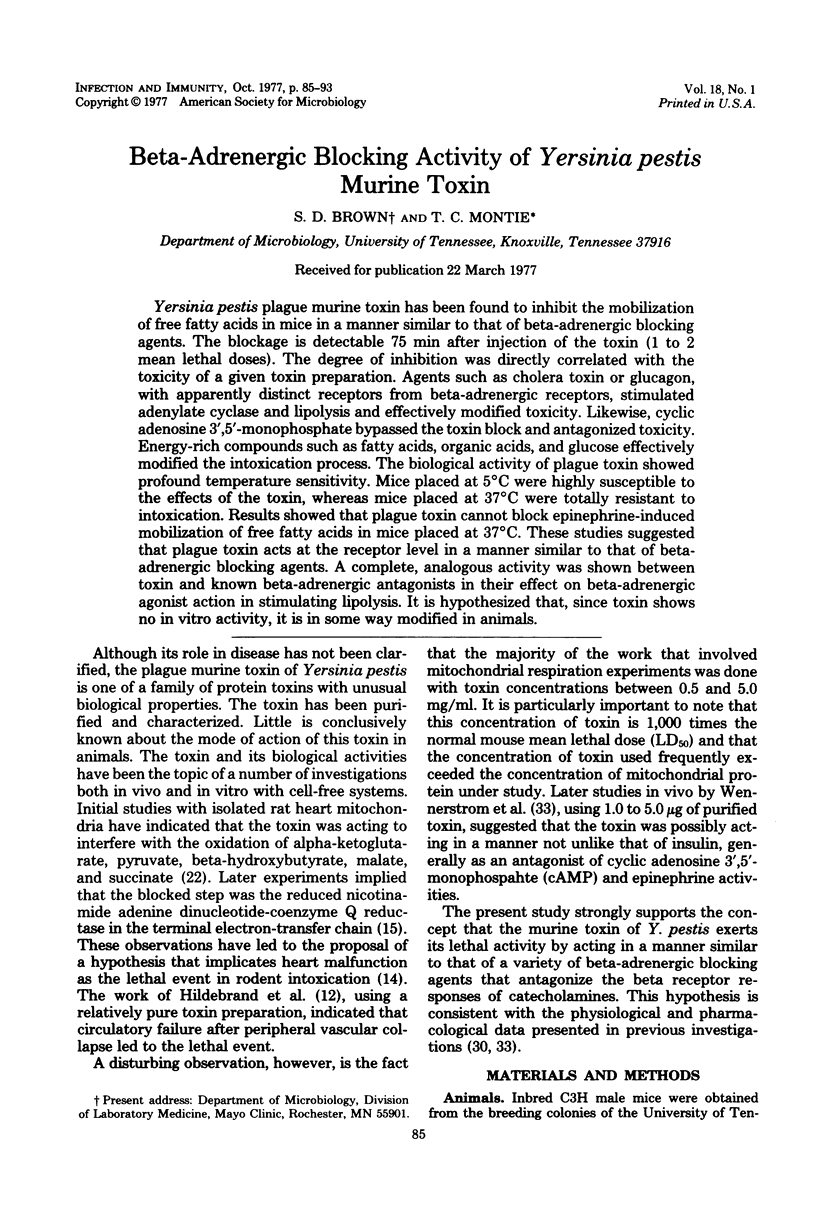
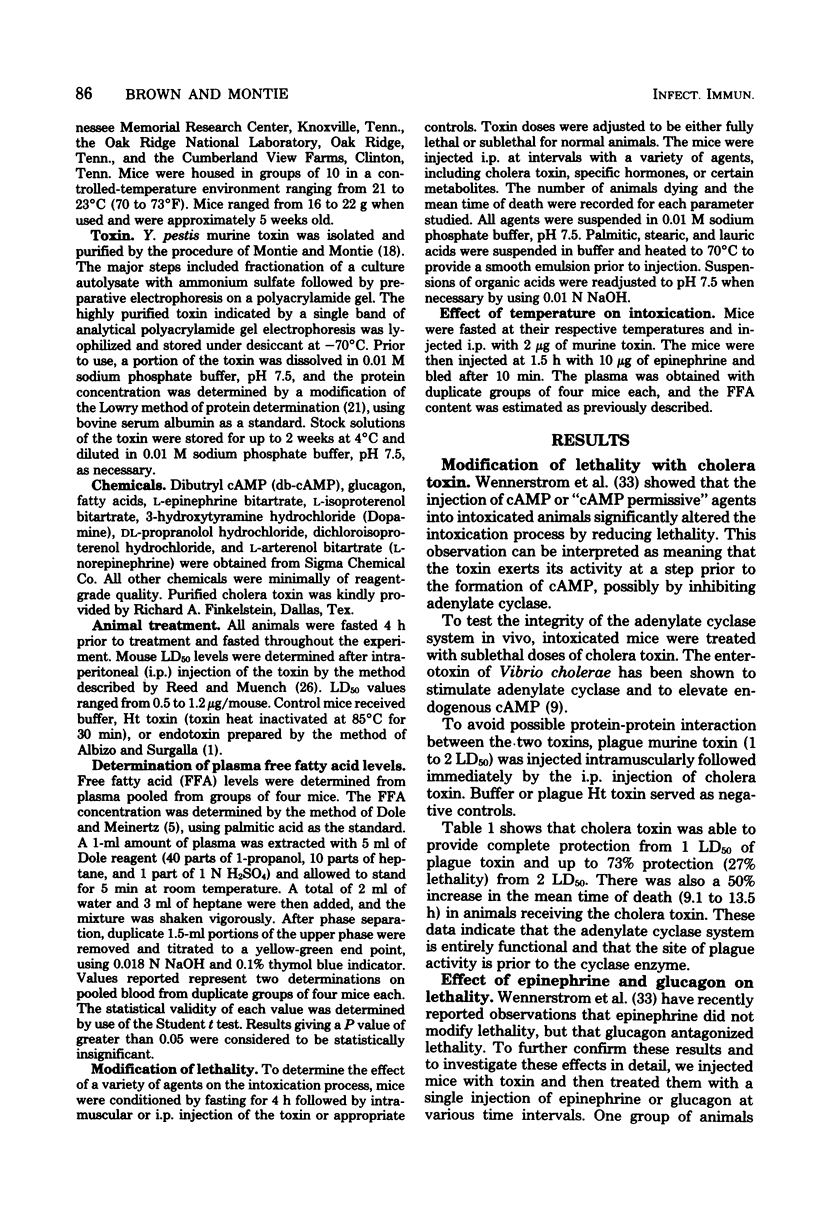
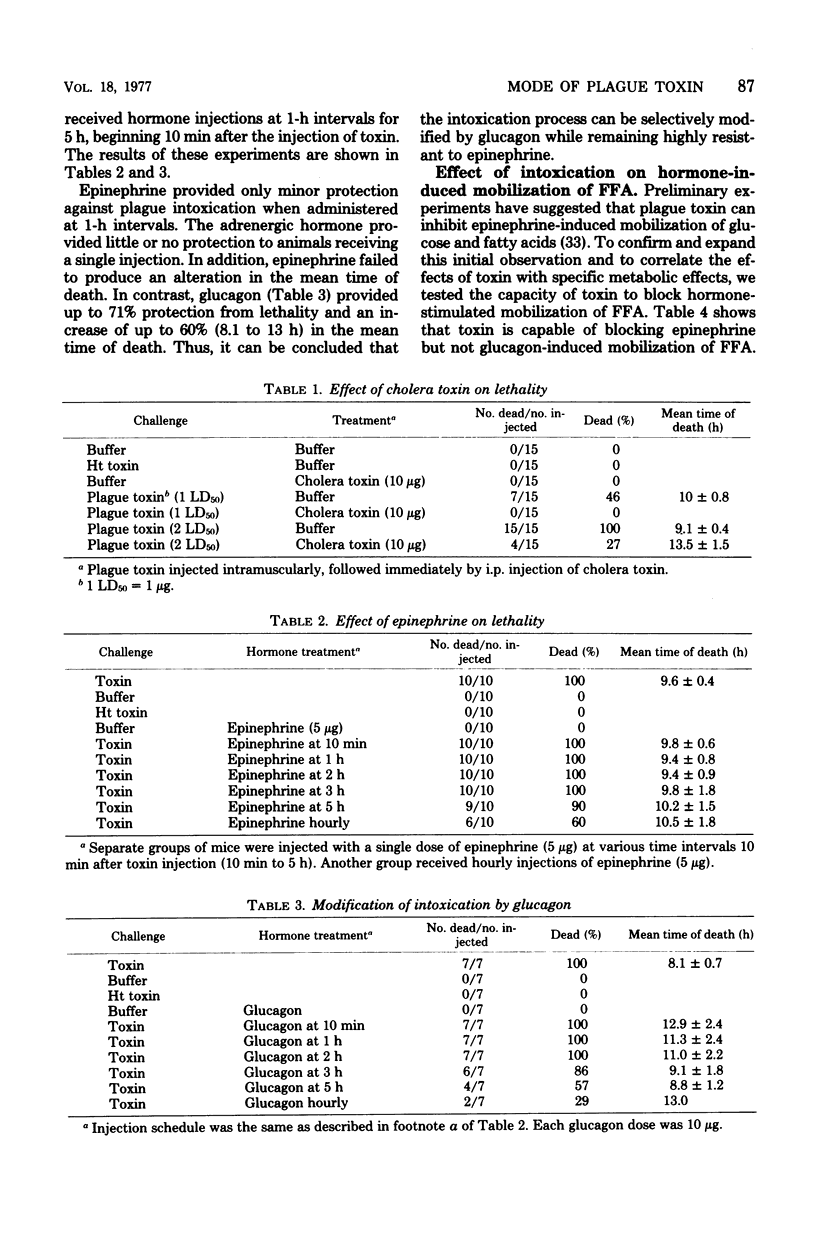
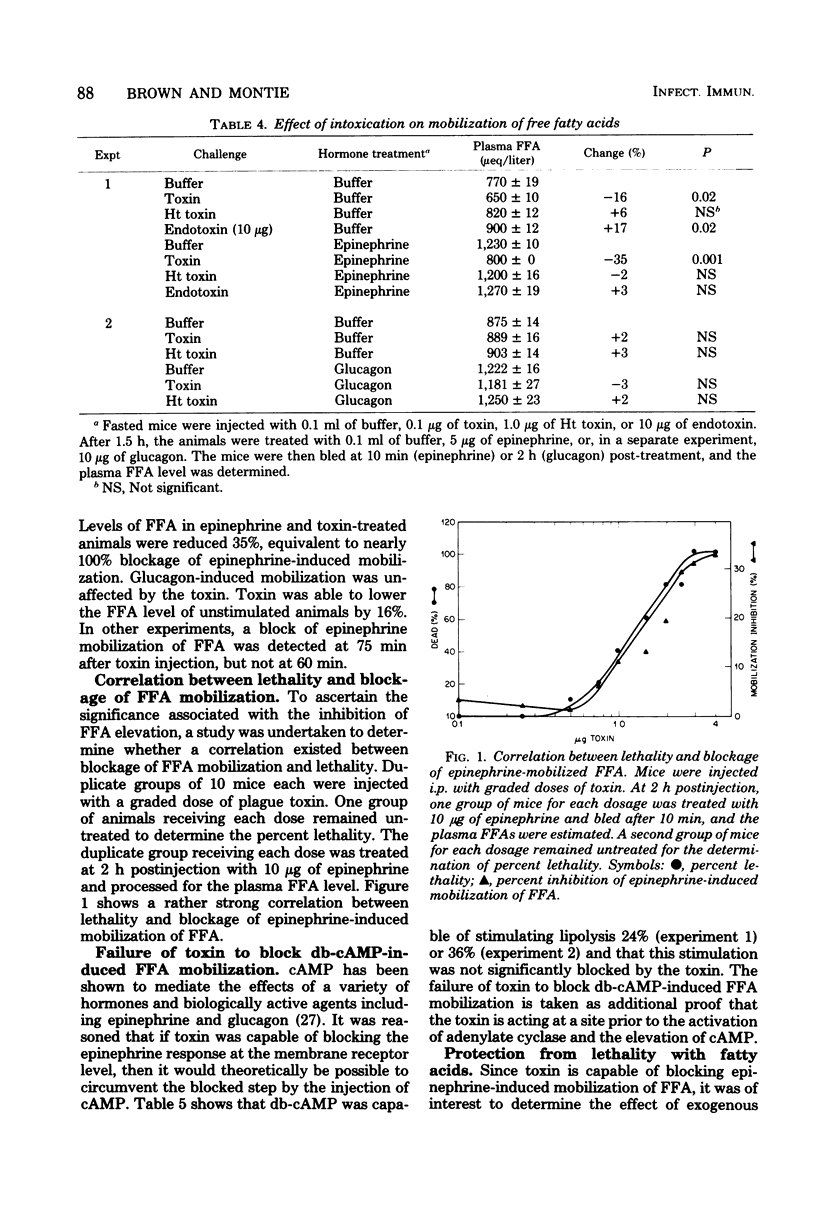
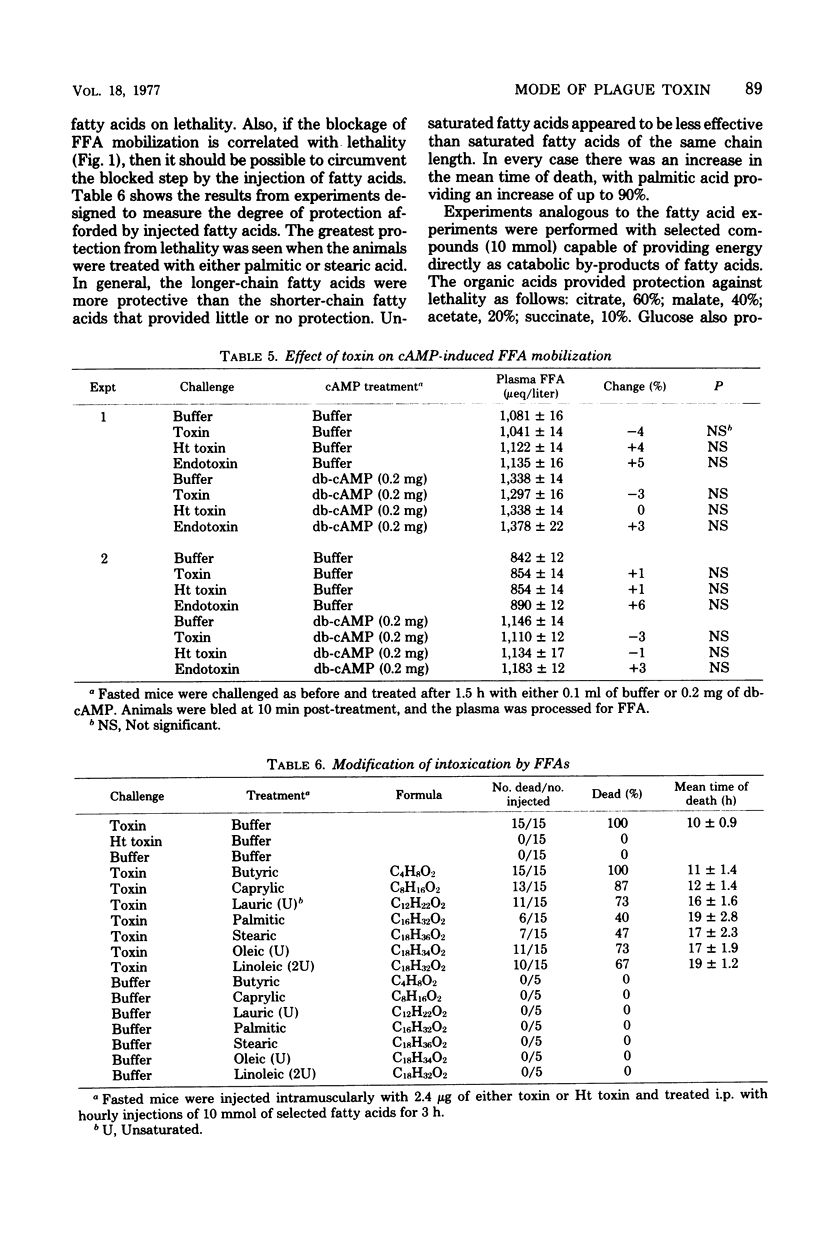
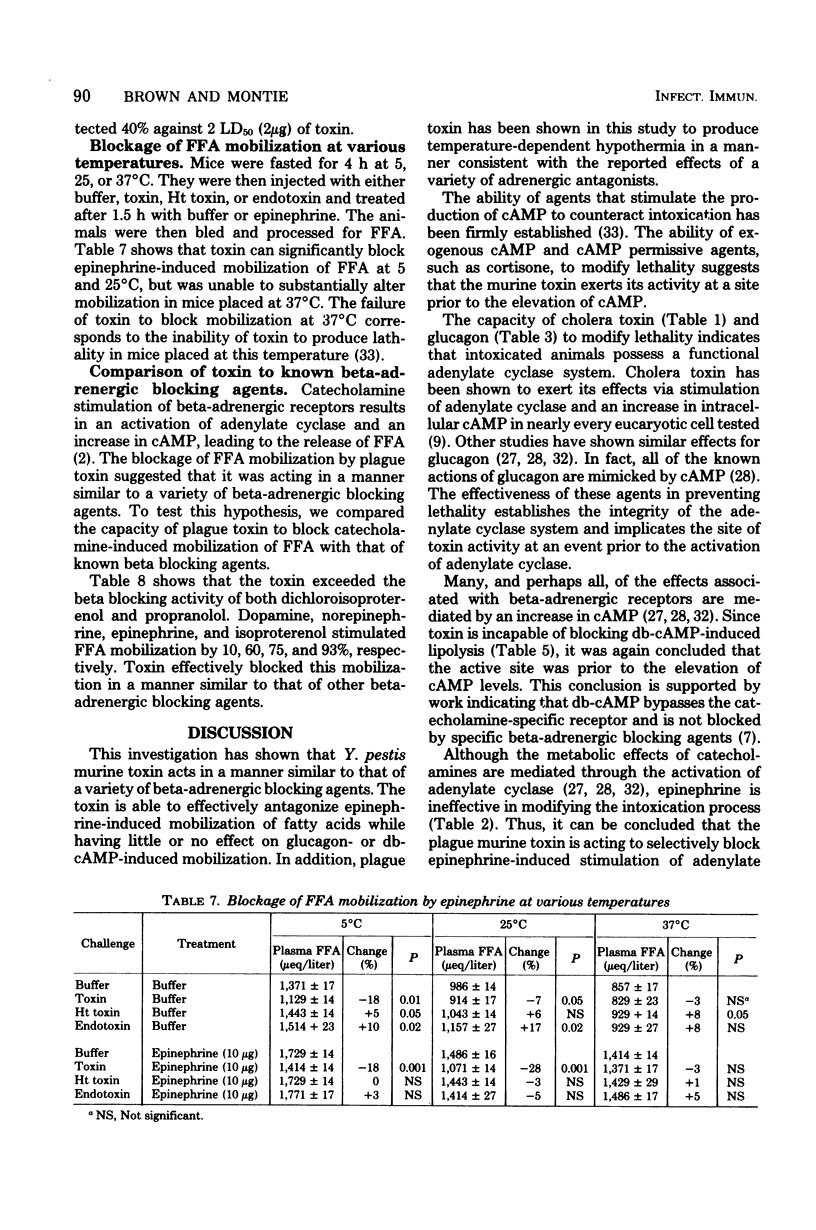

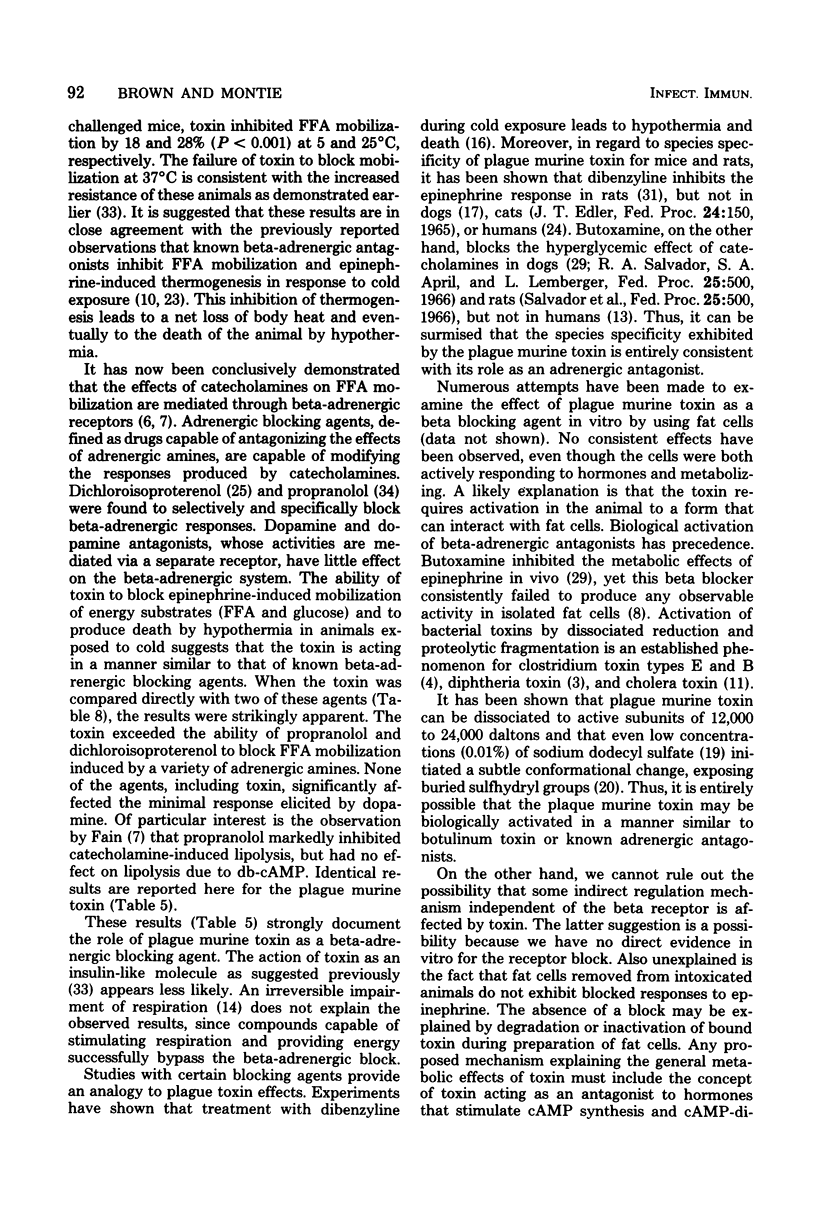
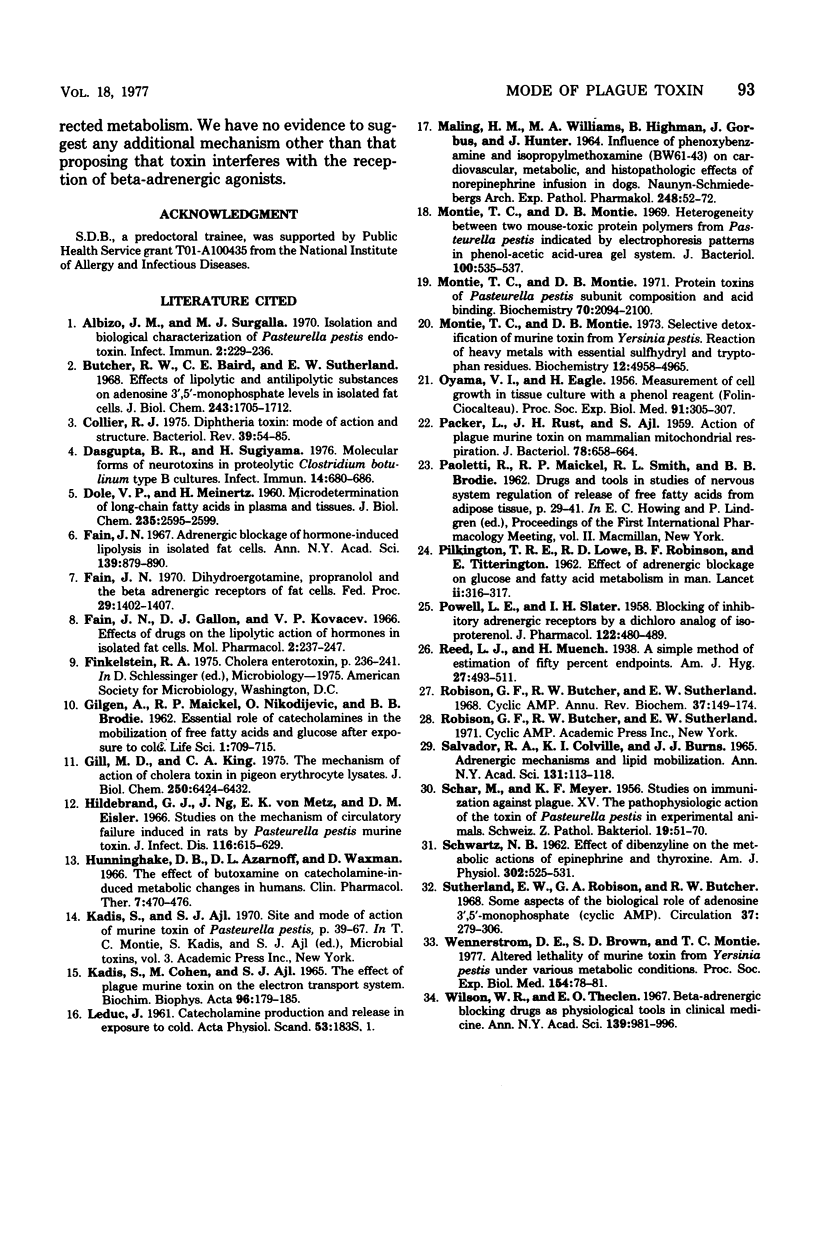
Selected References
These references are in PubMed. This may not be the complete list of references from this article.
- Albizo J. M., Surgalla M. J. Isolation and Biological Characterization of Pasteurella pestis Endotoxin. Infect Immun. 1970 Sep;2(3):229–236. doi: 10.1128/iai.2.3.229-236.1970. [DOI] [PMC free article] [PubMed] [Google Scholar]
- Butcher R. W., Baird C. E., Sutherland E. W. Effects of lipolytic and antilipolytic substances on adenosine 3',5'-monophosphate levels in isolated fat cells. J Biol Chem. 1968 Apr 25;243(8):1705–1712. [PubMed] [Google Scholar]
- Collier R. J. Diphtheria toxin: mode of action and structure. Bacteriol Rev. 1975 Mar;39(1):54–85. doi: 10.1128/br.39.1.54-85.1975. [DOI] [PMC free article] [PubMed] [Google Scholar]
- DOLE V. P., MEINERTZ H. Microdetermination of long-chain fatty acids in plasma and tissues. J Biol Chem. 1960 Sep;235:2595–2599. [PubMed] [Google Scholar]
- Dasgupta B. R., Sugiyama H. Molecular forms of neurotoxins in proteolytic Clostridium botulinum type B cultures. Infect Immun. 1976 Sep;14(3):680–686. doi: 10.1128/iai.14.3.680-686.1976. [DOI] [PMC free article] [PubMed] [Google Scholar]
- Fain J. N. Adrenergic blockade of hormone-induced lipolysis in isolated fat cells. Ann N Y Acad Sci. 1967 Feb 10;139(3):879–890. doi: 10.1111/j.1749-6632.1967.tb41257.x. [DOI] [PubMed] [Google Scholar]
- Fain J. N. Dihydroergotamine, propranolol and the beta adrenergic receptors of fat cells. Fed Proc. 1970 Jul-Aug;29(4):1402–1407. [PubMed] [Google Scholar]
- Fain J. N., Galton D. J., Kovacev V. P. Effect of drugs on the lipolytic action of hormones in isolated fat cells. Mol Pharmacol. 1966 May;2(3):237–247. [PubMed] [Google Scholar]
- GILGEN A., MAICKEL R. P., NIKODIJEVIC O., BRODIE B. B. Essential role of catecholamines in the mobilization of free fatty acids and glucose after exposure to cold. Life Sci. 1962 Dec;1:709–715. doi: 10.1016/0024-3205(62)90138-8. [DOI] [PubMed] [Google Scholar]
- Gill D. M., King C. A. The mechanism of action of cholera toxin in pigeon erythrocyte lysates. J Biol Chem. 1975 Aug 25;250(16):6424–6432. [PubMed] [Google Scholar]
- Hildebrand G. J., Ng J., Von Metz E. K., Eisler D. M. Studies on the mechanism of circulatory failure induced in rats by Pasteurella pestis murine toxin. J Infect Dis. 1966 Dec;116(5):615–629. doi: 10.1093/infdis/116.5.615. [DOI] [PubMed] [Google Scholar]
- Hunninghake D. B., Azarnoff D. L., Waxman D. The effect of butoxamine on catecholamine-induced metabolic changes in humans. Clin Pharmacol Ther. 1966 Jul-Aug;7(4):470–476. doi: 10.1002/cpt196674470. [DOI] [PubMed] [Google Scholar]
- KADIS S., COHEN M., AJL S. J. THE EFFECT OF PLAGUE MURINE TOXIN ON THE ELECTRON-TRANSPORT SYSTEM. Biochim Biophys Acta. 1965 Feb 22;96:179–186. [PubMed] [Google Scholar]
- MALING H. M., WILLIAMS M. A., HIGHMAN B., GARBUS J., HUNTER J. THE INFLUENCE OF PHENOXYBENZAMINE AND ISOPROPYLMETHOXAMINE (BW 61-43) ON SOME CARDIOVASCULAR, METABOLIC, AND HISTOPATHOLOGIC EFFECTS OF NOREPINEPHRINE INFUSIONS IN DOGS. Naunyn Schmiedebergs Arch Exp Pathol Pharmakol. 1964 Apr 21;248:54–72. doi: 10.1007/BF00247059. [DOI] [PubMed] [Google Scholar]
- Montie T. C., Montie D. B. Heterogeneity between two mouse-toxic protein polymers from Pasteurella pestis indicated by electrophoresis patterns in a phenol-acetic acid-urea gel system. J Bacteriol. 1969 Oct;100(1):535–537. doi: 10.1128/jb.100.1.535-537.1969. [DOI] [PMC free article] [PubMed] [Google Scholar]
- Montie T. C., Montie D. B. Protein toxins of Pasteurella pestis. Subunit composition and acid binding. Biochemistry. 1971 May 25;10(11):2094–2100. doi: 10.1021/bi00787a021. [DOI] [PubMed] [Google Scholar]
- Montie T. C., Montie D. B. Selective detoxification of murine toxin from Yersinia pestis. Reaction of heavy metals with essential sulfhydryl and tryptophan residues. Biochemistry. 1973 Nov 20;12(24):4958–4965. doi: 10.1021/bi00748a022. [DOI] [PubMed] [Google Scholar]
- OYAMA V. I., EAGLE H. Measurement of cell growth in tissue culture with a phenol reagent (folin-ciocalteau). Proc Soc Exp Biol Med. 1956 Feb;91(2):305–307. doi: 10.3181/00379727-91-22245. [DOI] [PubMed] [Google Scholar]
- PACKER L., RUST J. H., Jr, AJL S. J. Action of plague murine toxin on mammalian mitochondrial respiration. J Bacteriol. 1959 Nov;78:658–663. doi: 10.1128/jb.78.5.658-663.1959. [DOI] [PMC free article] [PubMed] [Google Scholar]
- PILKINGTON T. R., LOWE R. D., ROBINSON B. F., TITTERINGTON E. Effect of adrenergic blockade on glucose and fatty-acid mobilisation in man. Lancet. 1962 Aug 18;2(7251):316–317. doi: 10.1016/s0140-6736(62)90105-8. [DOI] [PubMed] [Google Scholar]
- POWELL C. E., SLATER I. H. Blocking of inhibitory adrenergic receptors by a dichloro analog of isoproterenol. J Pharmacol Exp Ther. 1958 Apr;122(4):480–488. [PubMed] [Google Scholar]
- Robison G. A., Butcher R. W., Sutherland E. W. Cyclic AMP. Annu Rev Biochem. 1968;37:149–174. doi: 10.1146/annurev.bi.37.070168.001053. [DOI] [PubMed] [Google Scholar]
- SCHAR M., MEYER K. F. Studies on immunization against plague. XV. The pathophysiologic action of the toxin of Pasteurella pestis in experimental animals. Schweiz Z Pathol Bakteriol. 1956;19(1):51–70. [PubMed] [Google Scholar]
- SCHWARTZ N. B. Effect of dibenzyline on the metabolic actions of epinephrine and thyroxine. Am J Physiol. 1962 Sep;203:525–531. doi: 10.1152/ajplegacy.1962.203.3.525. [DOI] [PubMed] [Google Scholar]
- Salvador R. A., Colville K. I., Burns J. J. Adrenergic mechanisms and lipid mobilization. Ann N Y Acad Sci. 1965 Oct 8;131(1):113–118. doi: 10.1111/j.1749-6632.1965.tb34783.x. [DOI] [PubMed] [Google Scholar]
- Wennerstrom D. E., Brown S. D., Montie T. C. Altered lethality of murine toxin from Yersinia pestis under various metabolic conditions. Proc Soc Exp Biol Med. 1977 Jan;154(1):78–81. doi: 10.3181/00379727-154-39608. [DOI] [PubMed] [Google Scholar]
- Wilson W. R., Theilen E. O. Beta adrenergic receptor blocking drugs as physiological tools in clinical medicine. Ann N Y Acad Sci. 1967 Feb 10;139(3):981–996. doi: 10.1111/j.1749-6632.1967.tb41266.x. [DOI] [PubMed] [Google Scholar]


